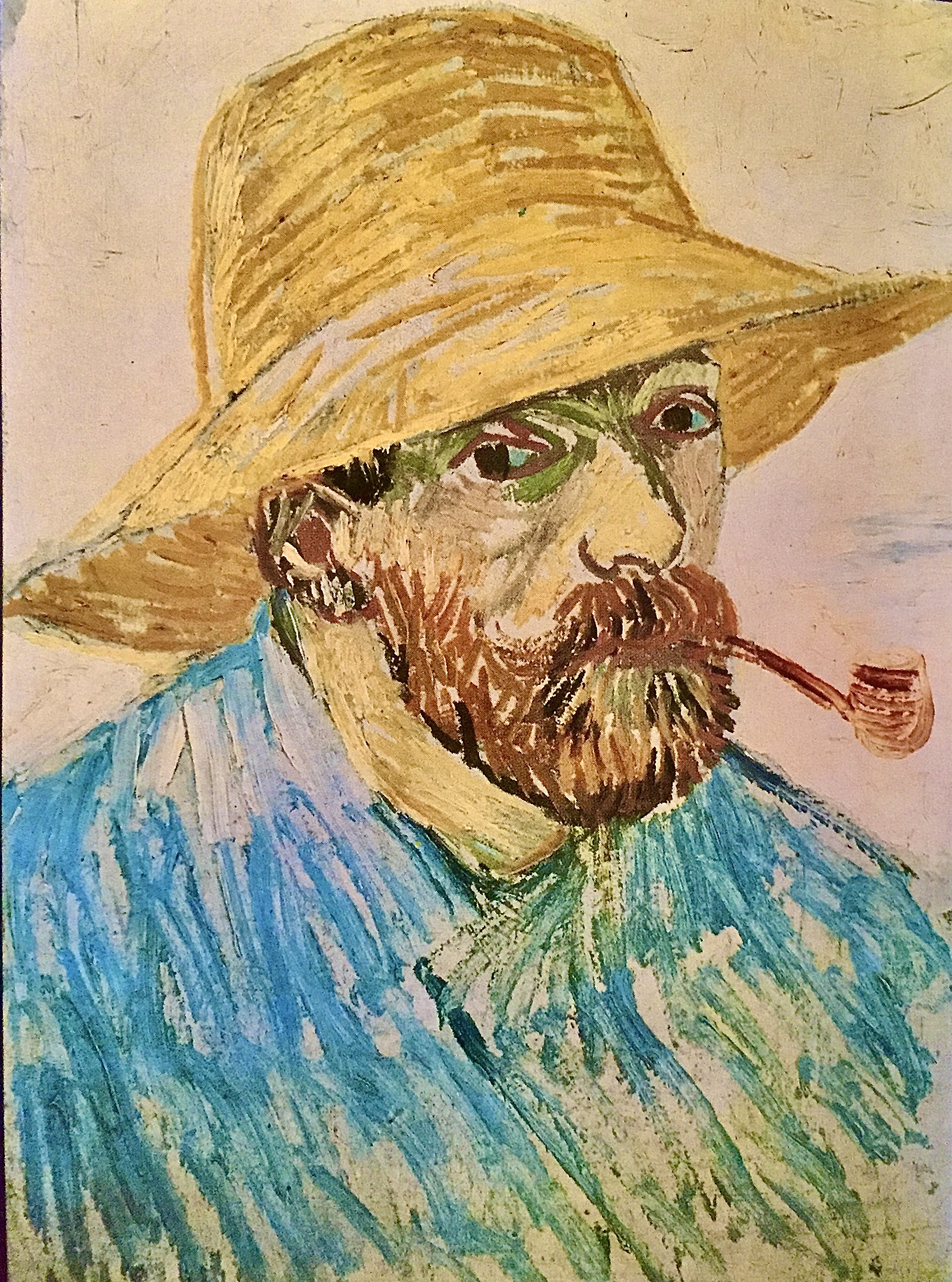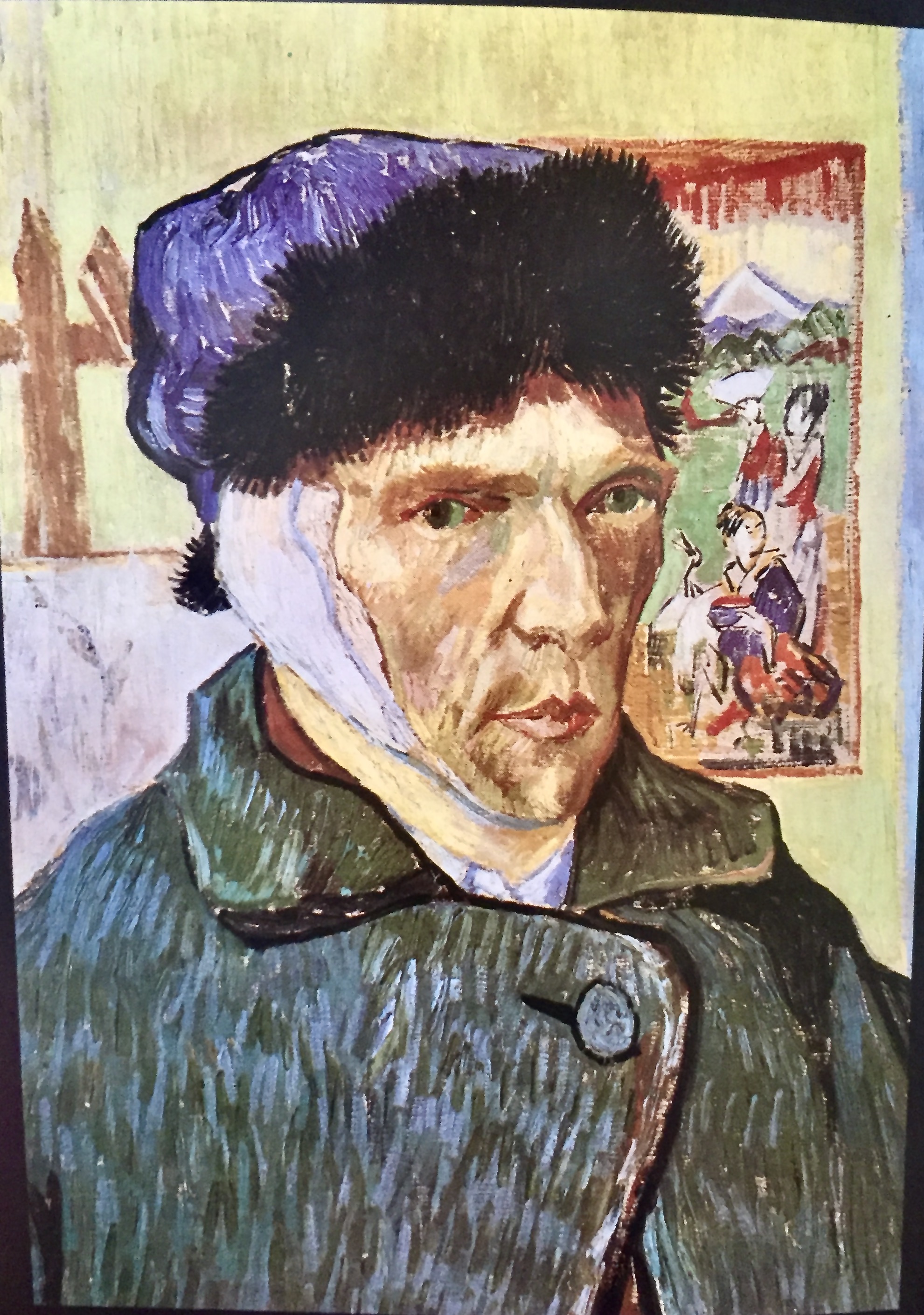By Cheryl Anderson
It’s impossible not to marvel at Vincent Van Gogh’s ability to recover from insurmountable emotional break-downs — yet, during periods of extreme visionary clarity produce remarkable works of art. Periodically during his life, again and again, he would reach shore getting his bearings only to reluctantly drift away and once more become mentally unmoored.

Self-Portrait with Straw Hat and Pipe, 1888

Self Portrait: with Bandaged Ear, 1889
Following a most difficult time in Paris with his brother, Theo, illness and a multitude of other conflicts, Vincent relocated to Arles, France in February of 1888. Summing up his feelings about living in Paris he wrote to his brother: “It seems to me almost impossible to work in Paris unless one has some place of retreat where one can recuperate and get one’s tranquility and poise back. Without that, one would get hopelessly stultified.”
Vincent was resolute and convinced he would be successful in achieving mental stability this time. He moved into what to some was a run down mess of a building in Arles — to him it was paradise giving him the feeling of having control of his life. Writing to his brother, Vincent said: “I feel that I can make something lasting out of it……The ground feels firmer underfoot, so let’s go ahead.” Vincent signed the lease before getting his brother’s approval. He had the building painted a buttery yellow color with striking green shutters. The Yellow House, remains one of his most recognizable paintings.

The Yellow House, 1888
His decision to use color had changed — he now began incorporating both complementary and contrasting color schemes. Gone were his earlier drab colors and subject matter as seen in, The Potato Eaters. Vincent’s acceptance of using color started during his time among the Impressionists in Paris prior to his move to Arles. By using vivid color schemes and incorporating the impasto technique his paintings became energetic, exuding his current positive attitude. Vincent described Arles as: “A little town surrounded by fields completely blooming with yellow and purple flowers; you know, it is a beautiful Japanese dream.”

View of Arles with Irises in the Foreground, 1888
In the south of France, a certain variety of almond tree can bloom as early as February. They caught Vincent’s eye immediately when he arrived in Arles and suited his optimistic mood at the time — to Vincent there was something about the budding trees that evoked hope and rebirth. He painted two images of almond branches in a glass that you may be familiar — there was snow during his first two weeks in Arles forcing him indoors. The influence of Japanese print-making can be seen in this series of fruit trees — notice the outlines and positioning of the trees in the picture plane. This can be seen in his paintings, Orchard with Blossoming Apricot Trees, Almond Tree in Blossom and Orchard in Blossom.

Almond Tree in Blossom, 1888 The simplicity of a single Almond tree expresses such hope as he began his move to Arles.
I find poignant the paintings, The Bedroom, and those of two chairs — one chair he bought for Gauguin he hoped would soon come to visit and the other for himself that shows his pipe on the cane seat. He did two more versions of The Bedroom when he was in St-Rémy. In preparation for Gauguin’s long-awaited visit, Vincent decorated the rooms with artwork to cheer-up his spartan surroundings— there was a spare room for Gauguin. After much pleading by Vincent, Gauguin at last arrived in Arles on October 23, 1888, only to leave in mid-December — he was unable to take Vincent’s mental deterioration and outbursts. At this juncture, Vincent severed his ear and nearly bled to death.

The Bedroom in Arles, 1889

Vincent’s Chair with His Pipe, 1888
During this period in Arles, ordinary life subject matter interested him a great deal — landscapes, farmhouses and wheat fields. The lone figure in The Sower, is especially moving — there’s a feeling of loneliness. Known for his sunflower paintings, Vincent would eventually paint ten pictures with sunflowers as the subject matter — Still Life: Vase with Fifteen Sunflowers was painted during the summer of 1888. The Red Vineyards, is the only painting thought to have been sold during Vincent’s lifetime for 400 FF.

Wheat Field with Reaper at Sunrise, 1889

The Sower, 1888-89

Still Life: Vase with Fifteen Sunflowers, 1888
Sadly, he was in the Hôtel-Dieu hospital in Arles during December and January suffering from hallucinations and delusions of being poisoned — only briefly returning to the yellow house by the beginning of January. In March, the house was closed to him and he was forced to move into rooms owned by Dr. Rey — people had complained that he was a danger to his neighbors. Vincent explaining that: “Sometimes moods of indescribable anguish, sometimes moments when the veil of time and fatality of circumstances seemed to be torn apart for an instant.” Vincent painted a portrait of Dr. Rey whose mother detested the portrait so much she used it to stop up a hole in the fence of her henhouse.
Suffering so intensely from severe mental and physical conditions, on May 8, 1889, Vincent voluntarily entered the Asylum of Saint-Paul-de-Mauisole located just outside of St.-Rémy-de-Provence. His accommodations consisted of two rooms — one serving as a studio. Vincent describes his new accommodations at the asylum thusly: “I have two views of the gardens and the asylum in which this place looks very attractive. I’ve tried to reconstruct as it might have been, simplifying and accentuating the proud and unchanging nature of the pine trees and the clumps of cedar against the blue.”

The Courtyard of the Hospital at Arles, 1889

Trees in the Garden of Saint-Paul Hospital, 1889
So moved when Vincent heard Theo’s new son, born January 31, 1890, would be named Vincent and that he would be the godfather, from memory he painted, Almond Blossoms, with a bright blue background. Theo telling Vincent: “As I told you, we’ll name him after you, and I’m making the wish that he may be as determined and as courageous as you.” It was to be hung over the infant’s bed. Theo’s wife wrote: “He always looks with very great interest at Uncle Vincent’s paintings.”

Almond Blossom, 1890 The painting given to Theo’s infant son.
As he was not allowed to leave the grounds of the asylum, the garden and interiors and exteriors of the hospital would become the main subjects of his paintings — as well as interpretations of other artist’s paintings, the enclosed wheat field he could see outside of his window, a few portraits and paintings from memory. Noon: Rest from Work, 1890, is based on the engraving by Jacques-Adrien Lavielle of Millet’s, The Four Hours of the Day. Occasional chaperoned walks led him to paint cypresses and olive trees.

Noon: Rest from Work, 1890
His mental health did not seem to affect his work except for those brief periods of deep despair and disquiet — he felt these periods more reflected simply his mood. Nature became an important subject matter — including trees, tree trunks, the landscape and even butterflies. To Vincent, caterpillars represented the opportunity for transformation and flowers in bud represented the cycle of life. A notable work of art from his time in Saint-Rémy is, The Starry Night — it was the view from his window of the asylum — one can easily see how his mind was swirling. Irises grew in the garden of the clinic which prompted him to paint, The Irises.

Trunk of an Old Yew Tree, 1888

Butterflies and Poppies, 1890

Starry Night, 1889

Irises, 1889
At last Vincent felt his future was bright— the hospital chart was marked cured. Prior to leaving Saint-Paul-de-Mausole asylum for Auvers-sur-Oise in May, 1890, he worked with frenetic speed— two examples of paintings produced during this frenzy are, Still Life with Pink Roses, showing roses spilling over the top of the vase with petals on the table and Still Life: Vase with Irises Against a Yellow Background. Writing to Theo: “I tell you, as regards work, my mind feels absolutely serene and the brushstrokes come to me and follow each other very logically.”

Still Life: Vase with Irises Against a Yellow Background, 1890
Vincent left Saint-Rémy in high spirits looking forward to a productive future. But for a gunshot wound he sustained in Auvers-sur-Oise, that after three days took his life, we would have many more stirring images on canvas that only he could give us.

Bench in the Park of the Asylum at Saint-Rémy, 1889
The years in Southern France would be the most productive in his career. He completed approximately 329 paintings while in Arles and Saint-Rémy.

A Pair of Shoes,1888

Café Terrace on the Place du Forum, at Night, 1888






